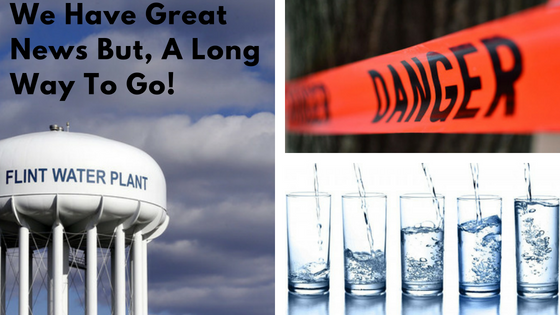We Have Some Great News But……..

All across the United States, we have had serious issues with our water quality. Center stage, of course, Flint, Michigan. The problem we have, Flint became such a big deal, other city violations snuck past the radar. Many of us who were signing petitions and donating money to help the poor people of Flint, had no idea our boat was ankle deep in water! In any given year from 1982 to 2015, somewhere between 9 million and 45 million Americans got their drinking water from a source that was in violation of the Safe Drinking Water Act, according to a new study. Most at risk: people who live in rural, low-income areas.
The internet and watchdog groups have been able to shine a spotlight on this gaping hole in our local, state, and the federal government. What we once took for granted, is now a significant health issue. The old theory that we have the best water just isn’t true. Our voices have been heard and there is good news.
On June 14, the Michigan Department of Environmental Quality approved the strictest rules in the U.S. targeting lead in drinking water. The new standards will bring the state’s maximum contaminant level down to 12 ppb in 2025, below the federal standard of 15 ppb. Additionally, the state has outlined a plan for full lead service line replacement, abandoning the practice of partial lead service line replacement, with the exception of emergency repairs.
According to The Detroit News, the new rules form a water system advisory council, require Michigan communities to develop water supply infrastructure inventories and increase water sampling standards. The decision to increase Michigan water quality standards was largely spurred by the Flint, Mich., water crisis and lead concerns that arose with it.
“As a state, we could no longer afford to wait on needed changes at the federal level, so Michigan has stepped up to give our residents a smarter, safer rule–one that better safeguards water systems in all communities,” said Mich. Gov. Rick Snyder in a statement.
The provision subject to the most controversy is a new standard that public water systems must replace 5% of lead service lines each year beginning in 2021 and extending over a 20-year period, with the end goal of replacing all of the state’s approximately 500,000 lead service lines, as reported by Reuters. While municipal water districts and environmentalists alike agree that replacing the lines are top priorities, many districts worry where the funding will come from and the strain it may take on taxpayers.
So we did it! We affected change and we will have safe drinking water again, in twenty years, hopefully. That is one city hoping to fix the problem of delivering poison water to your home in roughly 20 years, starting 3 years from now. 1 out of 89,004 local governments officially taken a stand after severe consequences were handed down.
Progress is progress and the fact that 15 people were criminally charged in the Flint, Michigan water crisis is good news. The future looks bright and a precedent has been set that there will be strict consequences for obstruction of justice and charges ranging from misconduct in office to involuntary manslaughter are being handed out. This is huge.
What do we do during the rebuilding cycle? Speak to a water quality specialist. Become educated about your water. Assume everything is not OK. Take matters into your own hands. Be in control of what you drink and bath in. Don’t become a statistic.







Leave A Comment